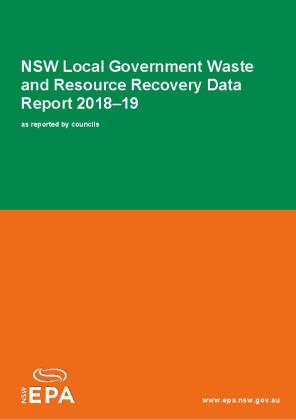Waste and recyclables collected from NSW households
The EPA coordinates annual council surveys on the waste and recyclables collected from households, which is the major component of the municipal solid waste (MSW) stream. The surveys also incorporate information required under the National Environment Protection Measure (NEPM) for Used Packaging Materials.
The resulting reports outline the domestic waste generation and recycling performance of local council kerbside, drop-off and clean-up services across NSW. The EPA uses data provided by councils to calculate overall waste generation and resource recovery rates for each local government area (LGA), and to prepare the yearly waste and resource recovery data reports.
When comparing the figures for LGAs, it is important to consider regional variations in consumption patterns, available services, data availability, and the interpretation of survey questions.
Waste and resource recovery data report 2018-19
The 2018–19 report findings show that
- NSW households generated a total of 3.66 million tonnes of domestic waste, sending 1.94 million tonnes of residual waste to landfill, with the remaining 1.72 million tonnes being recycled.
- The average NSW household generated 21.75 kg of waste a week.
- The average kerbside service collected 4.0 kg of recyclables, 5.3 kg of garden organics or 7.5kg of Food and Garden Organics (FOGO) and 10.9 kg of residual waste. The average person in NSW generated 8.8 kg of waste a week.
- The overall recycling rate for household waste was 47%, this has increased from 37.8% in 2005–06.
Download
- Local government waste and resource recovery data report 2018–19 (PDF 1MB)
- Appendices: Local government waste and resource recovery data report 2018–19 (XLSX 839KB)
See the local council waste and resource recovery data for previous years.
Household residual waste and recycling audit
2020 analysis of kerbside bin audits
In 2020, DPIE commissioned Rawtec to undertake an analysis of NSW council kerbside waste audit data to understand the amount of different waste types in kerbside residual waste bins and the performance of FOGO collection services funded under Waste Less Recycle More.
The Analysis of NSW Kerbside Green Lid Bin Audit Data Report (PDF 1408KB) is an update of an earlier report, first published in 2018. It incorporates 10 new data sets from audits which have been conducted since the original analysis.
The analysis shows FOGO services continue to deliver positive results. The average proportion of available food and garden organics diverted from landfill was 85% and the average level of contamination is just 2.2 per cent.
The Analysis of NSW Kerbside Red Lid Bin Audit Data Report (PDF 1821KB) compares kerbside residual red waste bin audit results from 64 New South Wales (NSW) councils in the waste levy area. This report provides an update on analysis conducted in 2010-11 and uses the old levy boundaries for comparison.
The findings show that overall generation has remained the same across NSW since 2011 (10.1 kg/bin/wk). However, significant differences now exist between areas. Households in the Sydney Metropolitan Area (SMA) area generate more waste overall. Households with a FOGO service generate less waste overall, recycle more and dispose of less waste to landfill.
2011 NSW domestic kerbside waste and recycling report
In 2011, 66 councils in the regulated area undertook weight-based audits of their domestic kerbside waste and recycling bins as a requirement of funding under the former Waste and Sustainability Improvement Payment (WaSIP) Program.
The audit revealed that the average residual waste bin in these areas of NSW contains 45% food and garden organics, 19.6% paper, 10.5% plastic and 3.7% glass.
2007-08 NSW domestic kerbside waste and recycling report
During 2007–08, councils in the Sydney Metropolitan Area, Illawarra and Hunter regions carried out a household residual waste audit, also as a WASIP requirement. The audits included household residual waste bins and some councils also included recycling and garden organics bins.
The audit revealed that the average residual waste bin in these areas of NSW contains 40% food waste, 11% garden organics and 23% dry recyclables.
Read the audit reports
- Domestic Kerbside Waste and Recycling in NSW: Results of the 2011 Waste Audits (PDF 681KB)
- Result of Waste Audits of Household Kerbside Collection Systems 2007–2008 (PDF 2.6MB)
More information
- The biennial WARR Strategy progress report provides updates on the community’s progress towards the NSW waste avoidance and resource recovery targets.
- Audit method: Guidelines for Conducting Household Kerbside Residual Waste, Recycling and Garden Organics Audits in NSW Local Government Areas (PDF 794KB)
- Changes to the audit method as a result of monitoring and evaluation: Guidelines for Conducting Household Kerbside Residual Waste, Recycling and Garden Organics Audits in NSW Local Government Areas – Addendum 2010 (PDF 209KB)


